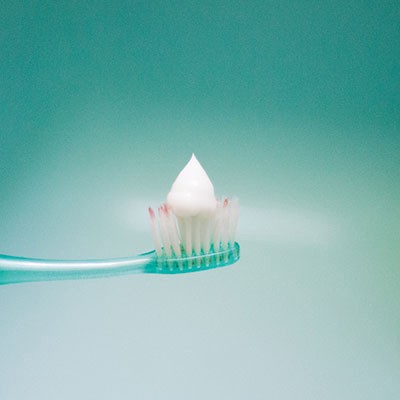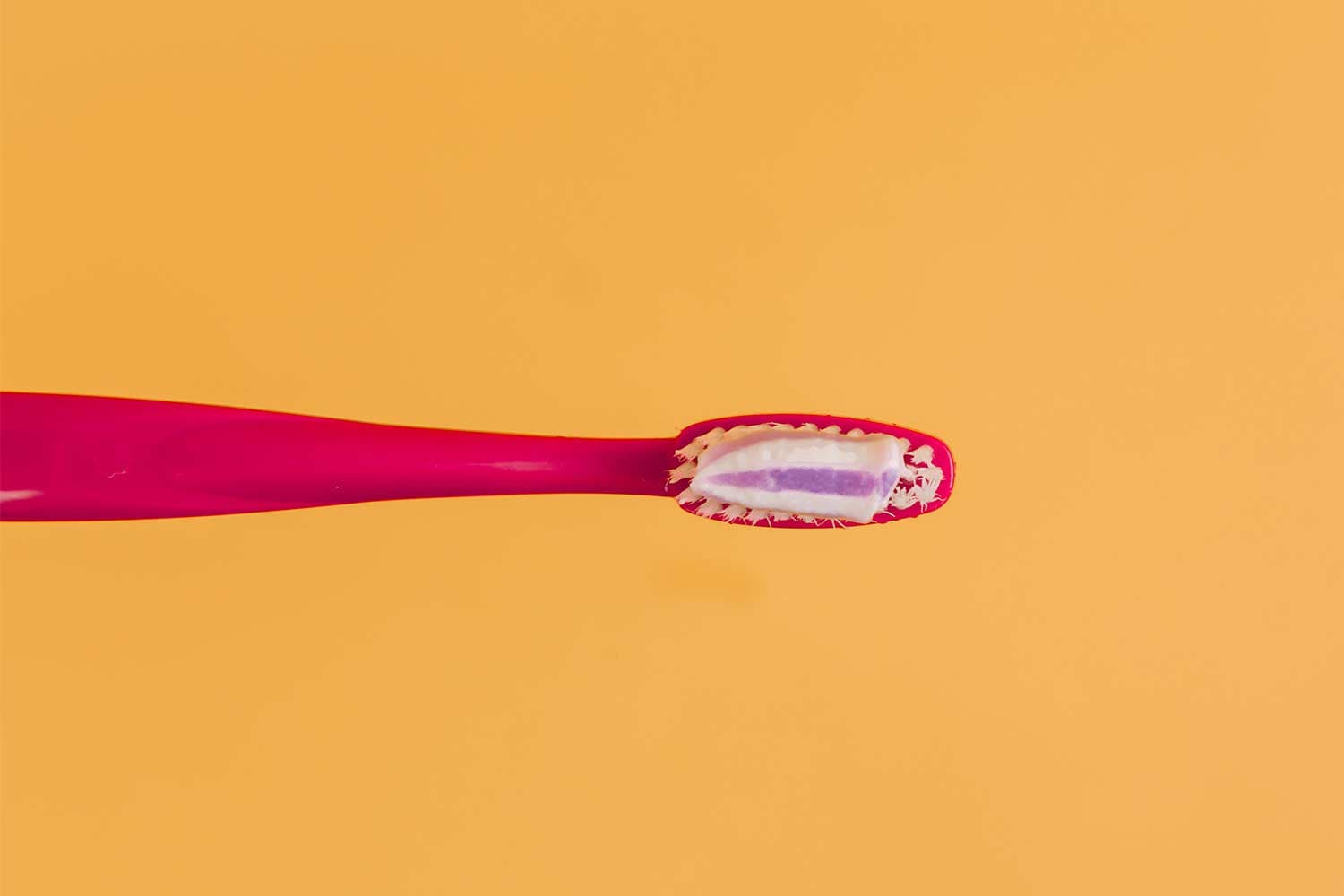Should We Worry About Fluoride?
Sink your teeth into the story of fluoride and how it affects our health and the environment.
Before “fluoride” became an omnipresent dental care ingredient, the term referred to any number of minerals containing the element fluorine, which is found in soil, plants, rocks, and water. Humans can be exposed to fluoride through food or fertilizers, but the most common source of fluoride exposure is drinking water. It can get there naturally (when water flows through rocks high in fluorides), intentionally (when water utilities add fluoride solution to the water supply), or as a result of industrial pollution. Fluorides are a byproduct of phosphate fertilizer manufacturing, and can leach into water supplies near fertilizer factories, as well as near phosphate rock mines.
The study of fluoride and teeth began in 1901, when dental school graduate Frederick McKay noticed Colorado schoolchildren’s teeth were marred by bizarre discoloration, dubbed “Colorado Brown Stain.” In 1909, McKay enlisted the help of dental researcher Dr. Greene Vardiman Black, and the two struggled for years to understand the cause of the stain and why stained teeth were less cavity-prone than unstained ones. Black died before their work was done, but 30 years after identifying the issue, McKay confirmed the cause of the teeth’s stains and strength: high levels of fluoride in drinking water.
Enter the US National Institutes of Health (NIH). The organization decided to continue the research on water-borne fluoride, and funded a method of measuring fluoride levels in water to an accuracy of 0.1 parts per million (ppm). By the late 1930s the NIH concluded that fluoride levels up to 1 ppm could improve dental health without causing enamel fluorosis (like Colorado Brown Stain). Decades later, the regulated use of fluorides in drinking water and dental hygiene are commonplace.
370 million people worldwide have access to fluoridated drinking water.
According to FDI (the world dental federation), 370 million people worldwide have access to fluoridated drinking water. Most US municipalities that fluoridate their water use fluorosilicic acid. Other countries — including Chile, Peru, the UK, and Russia — add fluoride to dairy products like milk, powdered milk, or yogurt.
It starts with a stone
So we’re putting fluoride in our mouths, via water, toothpaste, and maybe even yogurt. But how does it get there from its original mineral state?
Most fluorosilicic acid is a byproduct of manufacturing superphosphate fertilizers, which are used in conventional agriculture. Fertilizer production begins when phosphate rocks (minerals containing phosphorus) are mixed together and pulverized. As rocks from different sources contain different levels of phosphate, the blend is hammered until the mixture is uniformly 15% phosphate. The powdered rock is then combined with a sulfuric acid solution and mixed with more water.
The resulting “batter” flows out of the mixer, then additives like potash and limestone are added. The batter is then allowed to dry, and broken into tiny pieces by another hammer (the granulation process). Fluoride gas released in this process is captured, used to create fluorosilicic acid, and sold to water-processing facilities as is, or mixed with either caustic soda or sodium chloride to create sodium fluorosilicate or sodium fluoride, respectively. These fluorides can also be added to water, and sodium fluoride is used in toothpaste.
Some scientists believe supplies of phosphate rock will be drastically depleted by the end of the century.
Some scientists believe supplies of phosphate rock will be drastically depleted by the end of the century. “We are running out of [rock] phosphorus because we are mining it faster than it can be geologically regenerated,” explains Miguel Cabrera, professor of soil science at the University of Georgia at Tifton. With 82% of the world’s rock phosphorus used for crop fertilization, Cabrera points to animal manure, bone meal, or recycled sewage sludge as alternative phosphorus sources for agriculture.
If Cabrera and his peers are right, the fluoride industry may be out of luck, since none of those options are a likely source of fluoride for teeth. However, a 2013 blog post from Columbia University’s Earth Institute argues that what’s really running out are easily accessible phosphate reserves and inexpensive methods of extraction. The post quotes the institute’s Pedro Sanchez, who claims tectonic uplift is surfacing phosphorus at the same rate we’re using it. The post suggests more efficient mining and processing, and a return to organic fertilizers like those Cabrera suggested, can safeguard phosphate reserves.
From vat to tube
Once the fluoride has been manufactured, it’s off to the toothpaste factory. Toothpaste has contained a similar set of ingredients since the 1950s. A 1956 Procter & Gamble patent described toothpaste made of: a binder (in this case, carrageenan, an extract of the algae called Irish moss), non-aqueous liquids (glycerin), soluble dry powders (saccharin for sweetener), aqueous liquids (water or a water-based solution), and “substantially insoluble dry powders” (in this recipe: a synthetic foaming agent, flavor, and chalk).

Modern toothpaste typically has a non-aqueous liquid base of sorbitol (a compound naturally found in fruit) or glycerin (a byproduct of soap production). Specific ingredients vary between brands, but the most common binder is cellulose gum. Carrageenan is also still in use, as is xanthan gum, a fermented sugar. Modern “insoluble dry powders” include abrasives for polishing tooth enamel, like silica hydrate, sodium bicarbonate (baking soda), and calcium carbonate.
A mild surfactant makes toothpaste foam, helping it in the mouth longer. Sodium lauryl sulphate — typically produced from problematic palm oil — is most commonly used. Titanium dioxide gives toothpaste its white color; gels typically have food grade colorings added. Finally, manufacturers may also include preservatives, like sodium benzoate, ethylparaben, or methylparaben. And of course, fluoride is added. Sodium fluoride and its derivative sodium monofluorophosphate are the most common fluorides used in toothpaste. Once all the components have been combined, the toothpaste is injected into tubes.
Causes for concern?
So fluoride is fighting cavities in our teeth, but we know this because of the disturbing discoloration it caused a century ago. What else is it doing to us? And when our toothpaste goes down the drain, what is it doing to our ecosystems?
Fluorides are naturally occurring minerals, so they’re not a problem for us or the environment at the right concentrations. That said, Harvard Public Health magazine reported in 2016 that “evidence is mounting that … the potential risks from consuming fluoridated water may outweigh the benefits for some individuals,” like patients undergoing dialysis. Based on new data about young children’s tap-water consumption, the US Public Health Service reduced the level of fluoride it recommends for drinking water to 0.7 milligrams per liter in 2015. (Health Canada recommended the same level in 2010). As for the effects of dental fluoride on the environment, research suggests it doesn’t cause harm because of its low concentrations.
But, as with the children’s teeth in Colorado, humans and other life suffer from exposure to too much fluoride. Fluoride concentrations over 1.5 mg/L of water typically result in mottled teeth. In India, fluoride levels as high as 48 mg/L have been measured, and NGOs estimate that 60 million Indians are at risk of drinking over-fluoridated water. The country’s large (and growing) water needs have led to an increased dependence on groundwater from deep wells, where fluoride occurs in higher concentrations.
In India, fluoride levels more than 30 times the level that mottles teeth have been found in drinking water.
Fluoride ingestion at such elevated levels can result in brittle bones, brain damage in children, thyroid disorders, heart failure, bone cancer, and infertility in women. India has had a fluorosis prevention program in place since 2009, but a recent report in the Lancet quotes an NGO saying that “for a problem of this scale, the response has still been very patchy.”
Fluoride can also be an atmospheric pollutant, being released in gaseous forms by factories making bricks, steel, aluminum, glassworks, aluminum and ceramics. Too much fluoride in the air or water impacts plants and animals. In cattle, too much fluoride mottles teeth and deforms hooves. In chickens, high doses of fluoride affect liver and kidney function. A 2017 research review states that “Fluoride may stop photosynthesis and other essential processes in plants,” and identifies apricots, peaches, and lilies as among the most vulnerable to fluoride toxicity.
Fertilizer manufacturers aim to minimize environmental impact by using dust catchers when grinding phosphate rock, and filters to prevent emissions of fluorosilicic acid. Historically, government oversight has protected US residents from fluoride pollution. But with the Trump administration’s rollback of environmental regulations, there may be greater risk than in the recent past.
And what about that tube?
Since toothpaste is one of the main sources of fluoride in our lives, it’s worth a moment to look at its delivery method: toothpaste tubes. Typically, they consist of plastic laminate sandwiched around a layer of aluminum, which is impossible to recycle. According to STP ComplianceEHS — an organization that publishes environmental information for business — the US throws away a staggering 400 million toothpaste tubes a year. In 2019, Colgate announced plans for its Tom’s of Maine brand to switch to a recyclable version of the laminate. The company’s peppermint antiplaque toothpaste currently comes in the new packaging.
So even if fluoride is safe in the right quantities, this way of getting it to our teeth is usually a problem. And it’s an avoidable one. Many zero-waste toothpastes are now available, and while lots are fluoride-free, there are options for people who want fluoride. If that’s not you, homemade toothpaste is also an option! The story of fluoride doesn’t need to hurt people or the planet, but it matters how that story gets told.
Print Issue: Winter 2021
Print Title: The Story of Fluoride
